Last updated: September 2025
Applying for a car loan can feel like a paperwork marathon. Whether you’re a salaried employee with tidy W‑2s, a freelancer juggling 1099s, or a business owner reconciling bank statements, lenders want one answer: can you afford the payment? This guide clarifies what to submit—especially when it’s W‑2 vs 1099—and how to package your records so underwriters can verify income fast.
FinancialDocsProvider.com serves clients in the United States, United Kingdom and Canada by organising and improving the readability of your proof‑of‑income documents. We never falsify information or invent employers. We simply format, reconcile and present what you already have so lenders can review it quickly and confidently.
Related Entities & Terms
- W‑2 (US wage & tax statement), 1099‑NEC/1099‑MISC (US self‑employment forms)
- Pay stubs/payslips, paycheques, payroll summaries
- P60, P45 and SA302 (UK year‑end and self‑assessment tax forms)
- T4, T4A and Notice of Assessment (NOA) in Canada
- Bank statements, profit & loss statements, invoices, contracts
- Regulators: Consumer Financial Protection Bureau (CFPB), Federal Trade Commission (FTC), Internal Revenue Service (IRS), Financial Conduct Authority (FCA), Financial Consumer Agency of Canada (FCAC), Canada Revenue Agency (CRA)
- Auto loan concepts: annual percentage rate (APR), down payment, debt‑to‑income (DTI) ratio
- Credit bureaus: Experian, Equifax, TransUnion
What car loan income documents do lenders require?
Summary: Most lenders ask for recent, authentic proof of income that shows stability and capacity to repay. The exact forms depend on your employment type and country. Below we explain the core documents and when to submit W‑2 vs 1099.
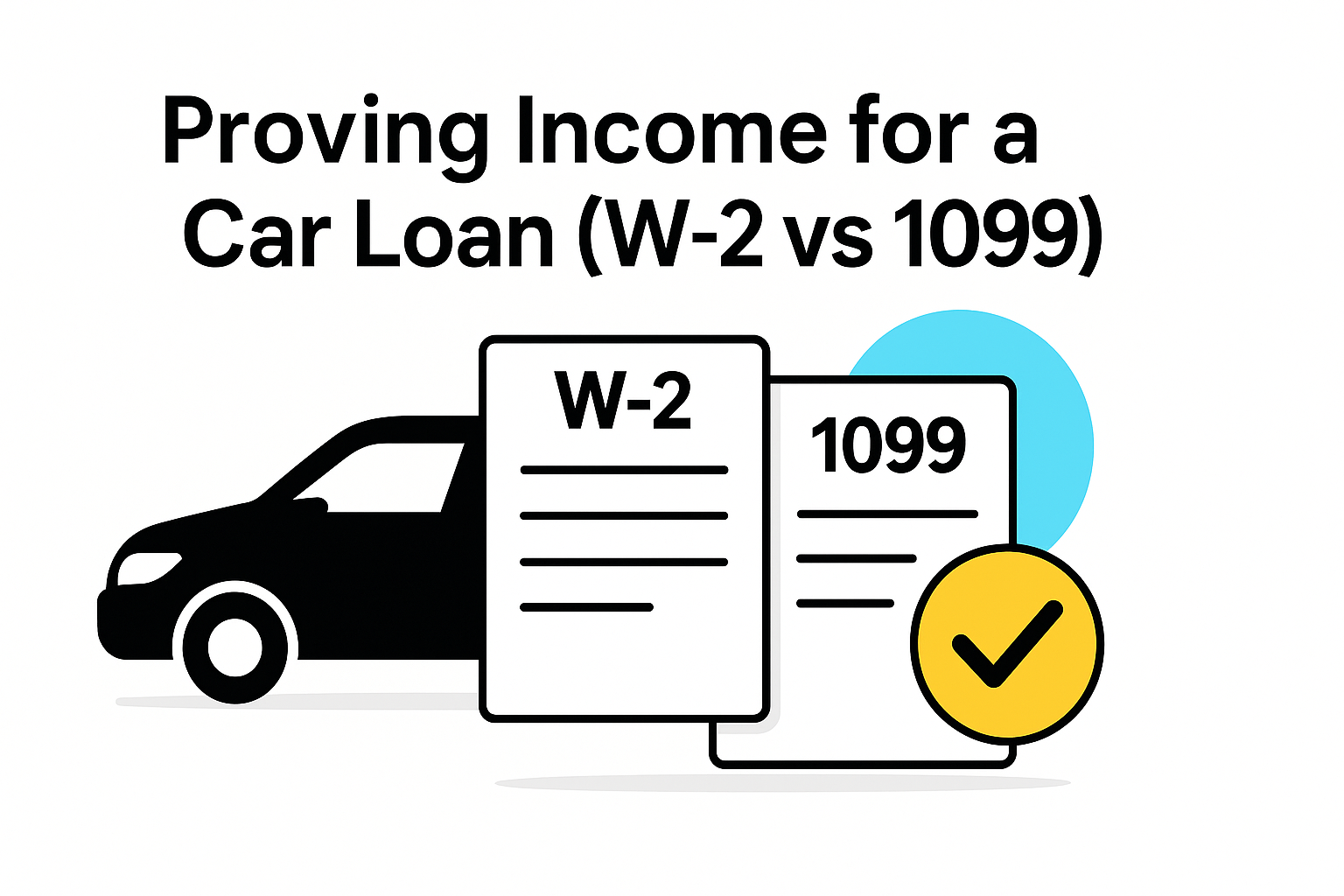
Auto lenders must verify your income before financing a vehicle. In the U.S., guidance from the Consumer Financial Protection Bureau reflects common practice: lenders typically request recent pay stubs, W‑2 wage statements for the last two years, signed tax returns, bank statements and documentation of other income sources. Industry checklists echo this advice, urging applicants to gather current pay stubs or bank statements, W‑2s, 1099s and two years of tax returns.
For salaried employees, the W‑2 issued each January summarises total wages and taxes withheld for the prior year. Lenders compare your W‑2s with recent pay stubs to confirm your year‑to‑date earnings align with annual totals.
Freelancers, gig workers and contractors receive 1099‑NEC or 1099‑MISC forms from each client who paid them at least US$600. Because 1099 income can fluctuate, lenders also review six to twelve months of bank statements, invoices and profit‑and‑loss reports to gauge consistency.
Outside the U.S., the documents are analogous. UK employees provide payslips and a P60 year‑end summary, while the self‑employed share SA302 tax calculations and bank statements. In Canada, lenders rely on T4 or T4A slips and may request a Notice of Assessment (NOA) downloaded from the CRA’s My Account, which summarises your taxable income and deductions.
Across all jurisdictions, authenticity is non‑negotiable. Lenders may confirm details with employers, banks or tax authorities. Altering amounts or dates is unethical and may be illegal; we cover the boundaries in the next sections.
Which edits to car loan documents are allowed?
Summary: Readability and privacy edits are fine; factual changes are not. You can redact sensitive identifiers, fix scanning issues and organise files into one clear packet. The rule is simple: improve clarity without altering the underlying data.
Formatting and readability improvements are perfectly legal. Lenders need to understand your financial picture quickly, so clean, legible documents help your case. You may redact personally identifiable information, clarify headings or combine multiple pages into a single PDF—as long as you do not change any material facts.
Here are examples of allowed edits:
- Redaction of sensitive data. You may blur or black‑out your Social Security number, National Insurance number (UK) or Social Insurance Number (Canada) to protect against identity theft. Keep the remaining content exactly as issued.
- Fixing formatting issues. It’s fine to rotate scanned pages, straighten lines, enlarge small text, correct scanning artefacts or convert a photo of a payslip into a clean PDF. You may also sort bank statements into chronological order or add bookmarks for fast navigation.
- Annotating or highlighting. Drawing a box around gross pay, year‑to‑date earnings or deposit amounts helps underwriters focus on critical figures. Use subtle highlights and avoid commentary that could be mistaken for changes.
- Consolidating documents. Combining your W‑2, recent pay stubs and bank statements into one PDF simplifies submission. Ensure each page contains the complete, unaltered information from the original.
- Language translations. For cross‑border applications, attach a certified translation of documents such as a French‑language T4 or a Spanish invoice. The translation should accompany—not replace—the original.
Our role is to perform only these permitted edits. We enhance clarity and presentation without ever changing numbers or dates. See Section What alterations are illegal and what are the consequences? for the boundaries.
What alterations are illegal and what are the consequences?
Summary: Any change that misrepresents facts can constitute fraud. Lenders verify income against employer records, bank data and tax transcripts. If the figures don’t match, you risk denial, account closure and—in serious cases—civil or criminal penalties.
Any change that misrepresents facts—however small—can be considered fraud. Auto lenders verify income by comparing your documents to employer records, tax transcripts and bank data. If discrepancies appear, your application can be denied and legal consequences may follow.
Examples of illegal alterations include:
- Changing amounts. Inflating hourly wages, bonuses or contract income to qualify for a larger loan is fraud. Erasing deductions or taxes to boost net pay will almost certainly be detected.
- Backdating or fabricating pay periods. Altering dates on a pay stub or bank statement to show continuous employment is a misrepresentation. Lenders often confirm pay dates and deposit amounts with employers or banks.
- Inserting fictitious employers or clients. Creating a fake company name or employer on a W‑2 or 1099 is illegal. Employer identification numbers can be cross‑checked, and references may be requested.
- Altering tax forms. Modifying a W‑2, 1099, P60, SA302, T4 or NOA by changing wages or taxes withheld is considered tax fraud. Authorities can impose fines or criminal charges for forging official forms.
- Combining numbers from different people. Mixing a partner’s income into your own pay stub or copying someone else’s bank statement violates privacy laws and misrepresents your finances.
Consequences vary by jurisdiction but can include loan denial, account closure, fines and prosecution. In the U.S., cases may involve the FTC or Department of Justice. In the UK, the FCA can prosecute under the Fraud Act. Canadian agencies such as the FCAC and CRA also treat falsification seriously. It’s simply not worth the risk.
When do you need professional document formatting for auto finance?
Summary: Straightforward cases may only require two or three pay stubs plus last year’s W‑2. Complex earnings, variable income or cross‑border histories often benefit from professional formatting that reduces questions and speeds approvals.
Many applicants can compile a simple package themselves. Yet there are scenarios where professional formatting adds real value. It can expedite underwriting, avoid unnecessary back‑and‑forth and help underwriters understand complex earnings.
Salaried employee with overtime and bonuses
Maria works for a technology company and receives a base salary plus quarterly bonuses. Her lender requests her most recent two pay stubs, last year’s W‑2 and evidence of her annual bonus. We organise the stubs in order, highlight bonus amounts and combine them with her W‑2 in one packet. The clearer presentation reduces underwriting questions and speeds approval.
Freelancer receiving 1099 forms
Ramon is a graphic designer who receives multiple 1099‑NEC forms from different clients. Because his income fluctuates, the lender asks for twelve months of bank statements, a profit‑and‑loss statement and at least two years of tax returns. We cross‑reference each 1099 with the corresponding bank deposits, annotate statements with invoice numbers and compile his Schedule C. The lender appreciates the thorough reconciliation and approves the loan on favourable terms.
Small business owner or partner
Priya owns a small consulting firm. Her income flows through a limited company in the UK, so she receives a mix of director’s salary, dividends and P60/SA302 forms. Lenders may struggle to interpret these sources. Priya sends us her company accounts, personal tax returns and payslips. We produce a consolidated packet with explanatory notes and translations where needed, ensuring each amount ties back to official filings.
Cross‑border and newcomer applicants
Alex moved from Toronto to the U.S. on a work visa. He must provide Canadian proof of income (T4, NOA) and new U.S. documents. We combine his Canadian and U.S. forms, add certified translations and highlight currency conversions where relevant. Similarly, a British expat in Vancouver may need to present both P60 and T4A slips. Professional formatting keeps nothing lost in translation.
These scenarios show when expert help is worthwhile. Our goal is to make your documents speak clearly and truthfully, regardless of how you earn.
How does FinancialDocsProvider.com help you with car loan documents?
Summary: We run a structured, compliance‑first process that prioritises accuracy, privacy and speed. We reconcile figures, improve legibility and assemble a lender‑ready packet—without changing a single fact.
We provide a streamlined service designed to minimise stress and maximise approval chances while staying within legal boundaries. Here’s how our approach works from intake to delivery.
- Initial consultation. Submit a secure request through our contact form or live chat. We discuss your employment status, lender requirements and jurisdictions involved.
- Document intake and reconciliation. Upload pay stubs, W‑2s, 1099s, tax returns, bank statements and any other relevant files. Our team cross‑checks that the numbers reconcile across sources—for example, total wages on your W‑2 should match the sum of your pay stubs.
- Formatting and redaction. We clean up scans, add bookmarks, redact sensitive identifiers, annotate key figures and assemble a cohesive PDF packet. For self‑employed clients, we align invoices and 1099s with bank deposits to show consistency.
- Final review and delivery. After quality checks, we deliver your organised proof‑of‑income packet via encrypted download link. Our typical turnaround time is 24–48 hours, depending on document volume. If the lender asks for more detail, we offer limited revisions at no extra cost.
Throughout the process, our role is to edit, format and organise—not to fabricate. We are transparent about our methods and provide guidance on what your lender will likely request. If you need additional support, such as bank statement formatting or proof of income editing, we can bundle those services too.
What belongs in a complete car loan proof‑of‑income package?
Summary: A thorough packet reduces delays and follow‑up requests. Assemble documents that prove your employment, earnings and identity, and make sure the numbers reconcile across forms.
A comprehensive packet lowers the chance that the underwriter will come back with questions. While requirements differ by lender and jurisdiction, the checklist below covers the most common items to gather before you apply.
- Employment verification. Recent pay stubs (usually the last two or three), an employment letter stating your role, salary and start date, and W‑2s for the previous two years.
- Tax forms. W‑2 (U.S.), P60/P45 (UK), T4/T4A (Canada) and, for the self‑employed, all relevant 1099s, SA302s, NOA and business tax returns. Remember that Form 1099‑NEC is typically issued to contractors by 31 January for payments over US$600.
- Bank statements. Provide at least three to six months of statements so the lender can see consistent deposits. If your income is irregular, submit up to twelve months.
- Profit & loss statements or accounts. Self‑employed borrowers should include a year‑to‑date profit & loss statement and, where applicable, a balance sheet. Some lenders may request a certified accountant’s letter.
- Additional income proof. Include documents for side income, alimony, child support, rental income or dividends, supported by official paperwork such as award letters or lease agreements.
- Identity and residence documentation. A government‑issued ID (driver’s licence or passport) and proof of address (utility bill or lease agreement). Some lenders also ask for proof of insurance.
- Cross‑border documentation. If you recently moved, include immigration documents (visa or work permit), plus translations of foreign income documents when required.
Keep high‑resolution digital copies. Label files clearly (e.g., “2024‑05 Pay Stub – Employer Name”) and confirm totals reconcile across forms. If you need help aligning numbers or verifying completeness, our financial document services can assist.
What red flags cause car loan documents to be rejected?
Summary: Underwriters look for consistency, completeness and legibility. Mismatched details, missing pages and obvious editing artefacts can slow or sink an application.
Lenders scrutinise documents for signs of tampering. Seemingly minor discrepancies can raise doubts and delay your application. To avoid rejection, watch out for these common issues:
- Mismatched information. Names, addresses or dates that differ across documents raise questions. If your payslip lists a different address than your bank statement, provide an explanation or proof of a recent move.
- Inconsistent earnings. Large income swings without context may prompt additional requests. If you received a big commission or contract payment, include an invoice or brief note explaining it.
- Poor formatting. Blurry scans, cut‑off pages, handwriting over figures or overlapping text make verification harder. Clean, legible documents convey professionalism and can speed approval.
- Missing pages. Omitting pages of a bank statement or tax return suggests something is hidden. Always include full statements, even if some pages are blank.
- Editing artefacts. Uneven fonts, misaligned numbers or different paper backgrounds can signal manipulation. Maintain the original look and feel of your documents.
- Unverifiable employers. If your employer or client can’t be found online or doesn’t return calls, lenders may question the income. Provide accurate contact details and be ready with additional proof.
A quick pre‑submission review catches many of these red flags. Our team is trained to spot inconsistencies and help you address them before your packet reaches the underwriter.
Where can you find official resources and further reading?
Summary: Use authoritative sources to understand your rights and obligations. The links below include government guidance as well as in‑depth articles from our team.
Consult trusted resources to ensure you know what lenders can ask for and how to prepare. These references offer clear, consumer‑friendly guidance.
- United States: The Consumer Financial Protection Bureau’s Ask CFPB explains how lenders evaluate income and offers tips for preparing a loan application. See also their guidance on creating a loan application packet, which lists pay stubs, W‑2s, tax returns and bank statements.
- Canada: The Canada Revenue Agency’s guide to obtaining a proof of income statement describes how to request your NOA and when lenders may ask for it.
- United Kingdom: The Financial Conduct Authority offers consumer guidance on credit agreements and warns against fraud. Their site includes resources on creditworthiness assessments and your rights as a borrower.
- Internal resources: Read our comparison of Pay Stub vs W‑2 for tips on choosing the right proof of income. For freelancers, our self‑employed car loan guide covers documents, rates and advice for 2025. To understand how many pay stubs you need for a car loan, see our article on pay stub requirements.
- General support: Explore our financial document services for help with proof of income editing and pricing information. If you have questions, feel free to contact our team.
Frequently asked questions
Summary: Quick answers to the most common proof‑of‑income questions. Follow your lender’s checklist first, then use these clarifications to avoid delays.
Do I need both pay stubs and W‑2s when applying for a car loan?
Most U.S. lenders ask for recent pay stubs plus your most recent W‑2. The stubs show current earnings, while the W‑2 verifies last year’s wages and taxes. If your income is stable, two to three stubs may suffice, but always follow your lender’s instructions. For UK and Canadian borrowers, provide payslips and P60/T4 forms as applicable.
How do freelancers and 1099 contractors prove income for auto finance?
Lenders look at bank statements, 1099s, invoices and tax returns. Self‑employed borrowers often must provide six to twelve months of bank statements, recent tax returns (including Schedule C) and a profit‑and‑loss statement. Make sure all documents reconcile across sources, and consider professional help to organise them.
Are digital copies and e‑signatures acceptable?
Yes. Most lenders accept scanned PDFs or digital statements if they are clear and unaltered. Electronic signatures on employer letters are generally fine if verifiable. Avoid low‑resolution screenshots and include every page of each statement.
What if I have multiple jobs or side gigs?
Provide proof for each income source. Attach pay stubs from your primary employer, 1099s from clients and bank statements showing deposits. Clearly label each document and include invoices or contracts where relevant. Lenders will aggregate verified income when calculating DTI.
Can I include other household income, like my partner’s wages?
Joint applications are common. If you apply together, submit separate proof of income for each applicant. Never mix your partner’s income into your documents—keep them separate and complete. Each applicant must meet their obligations and sign the agreement.
Need accurate, reliable financial documents fast? Contact FinancialDocsProvider.com now.

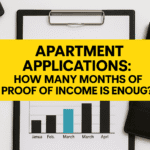
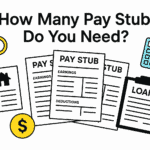
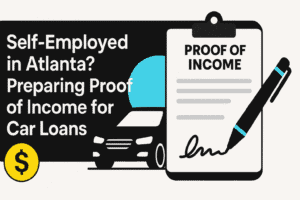
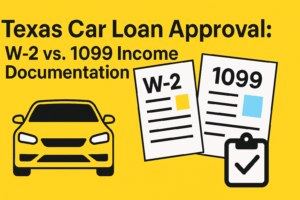
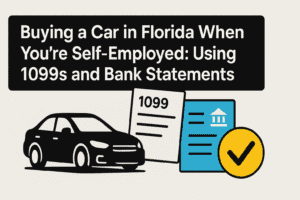

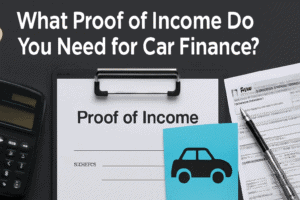
Add comment